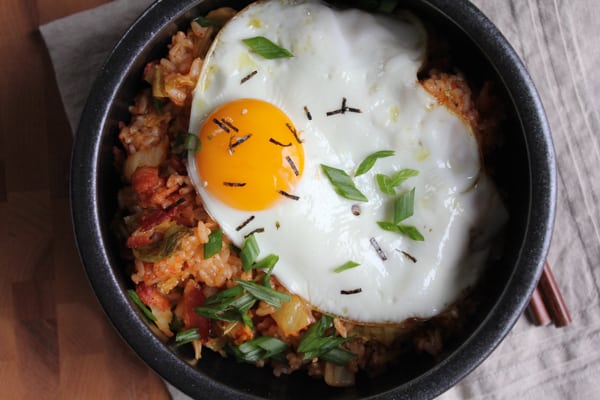Breakfast is considered an important meal in most Asian countries. In Korea, a complete set of traditional breakfast usually consists of rice, meat or fish, and several side dishes.
Conversely, modern Korean breakfast recipes offer lighter meals with easier preparation.
Some of them are even mixed with western and other Asian cuisines.
Let’s explore them all in the following recipes!
There are many reasons why this kimchi egg skillet can be a healthy morning meal for you. For starters, this dish is both gluten-free and dairy-free. More importantly, it only offers 57 calories in one serving. So, if you are in favor of a healthy breakfast, go for it!
Korean egg roll or gyeranmari is a light, simple meal that you can have in the morning. Besides, it is super easy to make. You only have to whisk a couple of eggs with some other ingredients, such as mushrooms, carrots, asparagus, green onions, or any of your favorite veggies.
If you prefer the bolder flavor, try this mouth-watering soybean paste stew, or as you can say in Korean: doenjang jjigae. Using tofu and soybean paste as the main ingredients, this hearty dish is quite high in protein. Doenjang jjigae is usually served with rice and a set of side dish named banchan (includes kimchi and seared fish).
Egg fried rice is a popular breakfast dish in Asia. In Korea, it is called gyeran bokkeumbap. This fried rice a la Korea features the appetizing smell of scallion and sesame oil. You can also sprinkle some sesame seeds as a garnish.
Street toast is one of the easiest Korean breakfast recipes that you can try at home. It consists of a hearty filling in between two pieces of butter-toasted bread. The filling is made by mixing cabbage omelet with ham, carrot, cheddar cheese and spring onion.
This is how a traditional breakfast in Korean looks like. It features a set of main and side dish: a bowl of rice, soybean stew, salted fish, fried egg, and Korean traditional pickled veggies or kimchi. Preparing the complete set of Korean breakfast may take time, but it’s all worth it.
Korean vegetable pancake, originally known as jeon, is prepared by mixing egg and flour batter with minced meat and some vegetables, preferably squash and Korean zucchini. The pancake is usually served with spicy dipping sauce.
This BBQ breakfast pizza is a delicious combination of the popular Italian dish with Korean cuisine and spices. Preparing the pizza is quite simple since you can use store-bought pizza dough and BBQ sauce. To make it more appetizing, top the pizza with over-easy egg, mozzarella, and fresh cilantro.
Kimchi rice bowl is another popular breakfast dish in Korea. In addition to kimchi and cooked white rice, this rice breakfast bowl is filled with bacon strips and fried eggs. It is also topped with several types of sauce, such as fish sauce, soy sauce, and gochujang or Korean hot pepper taste.
This is a great combination of Korean breakfast recipes and Mexican dish. You can use corn tortillas as the base while bulgogi or Korean meat stir-fry is served as the fillings. Add some homemade Korean slaw to complete the taste.
Dubu jorim or traditional braised tofu is commonly served in Korean restaurants. You can also make this high-protein dish at home and serve it for breakfast. To get the best result, include Korean red pepper powder in the tofu marinade.
Bibimbap, the ultimate Korean rice bowl, is surprisingly popular in other countries outside Korea. It is usually eaten at lunch, but by replacing some ingredients and modifying the toppings, you can eat this savory dish at breakfast or brunch.
Besides your usual oatmeal, Korean rice porridge is another hot and tasty alternative for breakfast. If you want it to be sweet and healthier, try this mouth-watering walnut porridge. Simply blend walnuts with grained rice and water, and then season them with a pinch of salt.
If you are a mushroom lover, enoki pancake is one of the Korean breakfast recipes you should try. This breakfast dish is filled with crisp texture and savory taste. You can also eat the mushroom pancakes as snacks or light meals in the afternoon.
In Korean tradition, rice cake soup or tteokguk is served in some special celebrations, especially the Lunar New Year. To make this soup, rice cake slices are cooked in beef or anchovy stock. For serving, the soup is usually topped with nori sheets, chopped scallions, and eggs.
Egg is a versatile ingredient in Korean breakfast meals, whether you use it in the main dish, side dish, or as the additional topping. This steamed egg pot is another great example. It is seasoned with fish sauce and drizzled by sesame oil.
Bindaetteok or savory Korean pancake is made by mixing gluten-free mung bean flour with scallion and the traditional cabbage kimchi. You can serve it with sunny-side egg as the topping and Korean hot sauce as a spicy addition.
Chicken porridge or dakjuk is an alternative variation of the Korean light meal that you can eat for breakfast. It is usually served as comfort food—just like chicken soup when you’re sick. This creamy chicken porridge will warm you up in a cold morning.
In this savory morning meal, Korean breakfast recipes meet the traditional Indian bread, parathas. The bread is made with chapatti flour, while egg and kimchi are used as the fillings. For the final touch, garnish the parathas with scallion slices.
You might also like:






















